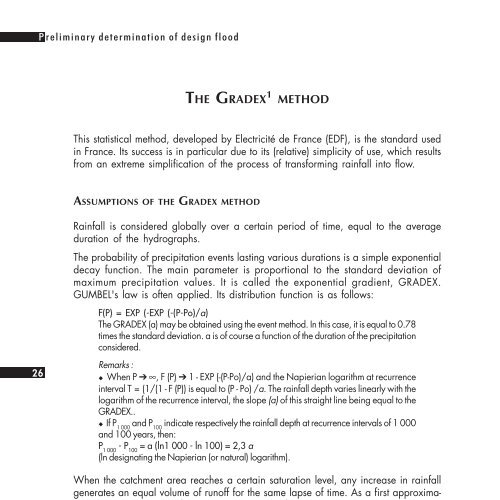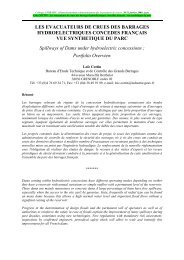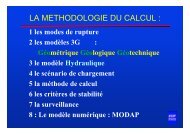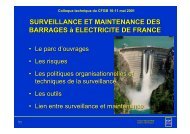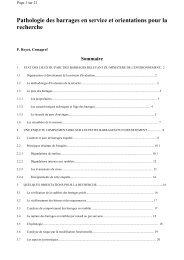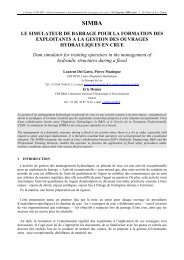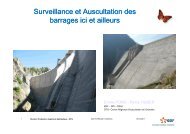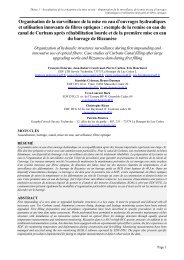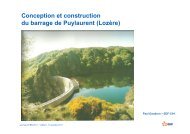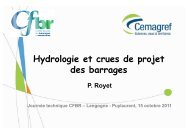SMALL DAMS
SMALL DAMS - Comité Français des Barrages et Réservoirs
SMALL DAMS - Comité Français des Barrages et Réservoirs
- No tags were found...
Create successful ePaper yourself
Turn your PDF publications into a flip-book with our unique Google optimized e-Paper software.
P reliminary determination of design flood<br />
THE GRADEX 1 METHOD<br />
This statistical method, developed by Electricité de France (EDF), is the standard used<br />
in France. Its success is in particular due to its (relative) simplicity of use, which results<br />
from an extreme simplification of the process of transforming rainfall into flow.<br />
ASSUMPTIONS OF THE GRADEX METHOD<br />
26<br />
Rainfall is considered globally over a certain period of time, equal to the average<br />
duration of the hydrographs.<br />
The probability of precipitation events lasting various durations is a simple exponential<br />
decay function. The main parameter is proportional to the standard deviation of<br />
maximum precipitation values. It is called the exponential gradient, GRADEX.<br />
GUMBEL's law is often applied. Its distribution function is as follows:<br />
F(P) = EXP (-EXP (-(P-Po)/a)<br />
The GRADEX (a) may be obtained using the event method. In this case, it is equal to 0.78<br />
times the standard deviation. a is of course a function of the duration of the precipitation<br />
considered.<br />
Remarks :<br />
!"When P ➔ ∞, F (P) ➔ 1 - EXP (-(P-Po)/a) and the Napierian logarithm at recurrence<br />
interval T = (1/(1 - F (P)) is equal to (P - Po) /a. The rainfall depth varies linearly with the<br />
logarithm of the recurrence interval, the slope (a) of this straight line being equal to the<br />
GRADEX..<br />
!"If P 1 000<br />
and P 100<br />
indicate respectively the rainfall depth at recurrence intervals of 1 000<br />
and 100 years, then:<br />
P 1 000<br />
- P 100<br />
= a (ln1 000 - ln 100) = 2,3 a<br />
(ln designating the Napierian (or natural) logarithm).<br />
When the catchment area reaches a certain saturation level, any increase in rainfall<br />
generates an equal volume of runoff for the same lapse of time. As a first approximation,<br />
this state is reached for recurrence intervals of ten years (impermeable catchments,<br />
with low retention), to 50 years (permeable catchments, with high retention).<br />
The runoff law is obtained quite simply by translating the rainfall depth law to the<br />
point of the 10 or 50 year recurrence interval.<br />
A physical interpretation of this process can result from observation of the graph of<br />
runoff variations relative to the amount of rainfall (see fig. 1, p. 35). The retention<br />
capacity of the catchment area is schematically represented by the difference between<br />
the bisector (rainfall = runoff) and its parallel, plotted in the middle of a cloud of<br />
points.<br />
1. See Bibliography, references 5, 7 and 11, p. 36.


